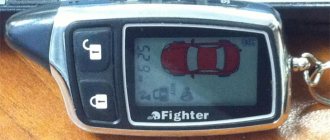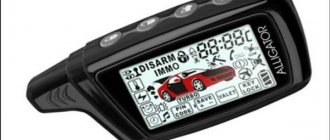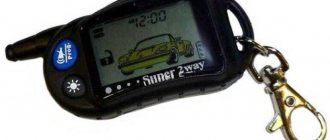Operating instructions A.P.S. 2100
Pay attention to the 3 main components of your APS 2100 security system
: - Key fob transmitter - LED System Status Indicator (LED) - Vale switch
1. Key fob transmitter with a dynamic code The APS 2100 car alarm kit includes two key fobs transmitters with a dynamic code based on the KEELOQ microprocessor. Each time you press the transmitter button, the code will automatically change in random order. Thus, your system is protected from attempts to “intercept” your transmitter code using a code grabber. During operation, a situation may arise when the codes of the key fob transmitter and the main unit of the system become desynchronized (for example, if you press the transmitter button more than 30 times away from the car). In this case, you will only need to approach the car and quickly press the transmitter button twice. There are two buttons on your transmitter key fob: a large left button and a small right button. The functions of these buttons are given below: Large Left Button - Used to arm and disarm the system. Small right button - used for silent arming and disarming of the system, for controlling the output of the 2nd channel, and, together with the Large left button, for arming the system with disabling the shock sensor. Both buttons pressed together control the remote “Panic” mode and enable the Anti-Carjacking anti-theft function. 2. System Status LED (System Status Indicator) The LED informs the vehicle owner about the status of the security system and indicates the zone or trigger that caused the system to activate. 3. Valet switch This switch allows you to temporarily disable the security functions of the system (by switching the system to the Valet service mode). It is also used in conjunction with the ignition key to emergency disarm the system in case of loss of the transmitter, to disable Anti-Carjacking mode, to program system functions and to program new transmitters.
APS 2100 OPERATING MANUAL
1. Installation of the APS 2100
to arm using a transmitter Turn off the ignition, get out of the car and make sure that all doors, hood and trunk are closed.
Press and release the Large Left Transmitter Button once. You will hear the siren confirm once, the parking lights will turn on once and the LED will flash slowly. The system will also automatically lock the car door and block the starter (or ignition). 2. Arming the APS 2100 system by disabling the shock sensor To arm the system by disabling the shock sensor, press and release the Large left button of the transmitter (the siren will give 1 confirmation signal and the parking lights will turn on once) and then press and release within 3 seconds Small right button. The siren will give an additional 1 long confirmation signal and the side lights will turn on for several seconds, confirming that the system is armed, but the shock sensor input is disabled. 3. Bypassing a faulty zone when arming a) If one of the doors, hood or trunk is not closed, or if one of these circuits is faulty, then when arming the system using the transmitter you will hear 3 siren signals (instead of one) and side lights lights will flash 3 times. This will bypass the open or faulty circuit and the LED will flash 2 or 4 times, paused for 30 seconds, indicating the faulty and bypassed circuit (door or hood/trunk, respectively). b) If the shock sensor circuit is faulty, then 5 seconds after arming the APS 2100 system (i.e. after 1 siren signal), you will hear 3 more siren signals and the side lights will flash 3 times. The LED will then flash in a series of 3 flashes, pausing for 30 seconds. c) Once the bypassed circuit during arming is closed or corrected, the system will also immediately arm it. 4. Automatic (passive) arming of the APS 2100 system
1. Turn off the ignition, get out of the car and make sure that all doors, hood and trunk are closed.
Once the last door has been closed, the LED will begin to flash rapidly to indicate that the time is counting down before the system will automatically arm. 30 seconds after the last door has been closed, you will hear 1 siren signal, the side lights will turn on 1 time and the LED will flash slowly. At this point, the system will also automatically lock the car door (if function #2 is enabled) and block the starter (or ignition). If one of the doors, hood or trunk is opened during the 30-second countdown before the system is automatically armed, the LED will turn off and the countdown will be stopped. Once all doors, hood and trunk are closed again, the LED will again flash rapidly and the 30-second countdown will begin again. The automatic arming function (features #1 and #2) is programmable and you can disable it at the customer's request. The programming procedure is described in the “Programmable system functions” section. ATTENTION: In the automatic arming mode, the open or faulty circuit bypass function will NOT work! Since the countdown for automatic arming of the A.PS 2100
begins only after the last door has been closed, if one of the doors, hood or trunk is left open, or if one of these circuits is faulty, automatic arming will not begin. You can, however, arm the system at any time using the transmitter. If only the shock sensor circuit is faulty, 5 seconds after automatic arming, the siren will sound 3 more times, the side lights will flash 3 times and the LED will flash in a series of 3 flashes after a pause for 30 seconds, indicating that this circuit has been bypassed. 2. If you want to temporarily disable the automatic arming function, turn off the ignition and within 3 seconds press and hold the Large Left button of the transmitter until the siren gives one short confirmation signal. After this, the automatic arming feature (or the automatic engine immobilization feature, if this feature is enabled) will be temporarily disabled until the next time the ignition is turned on, regardless of whether the vehicle doors are closed or unlocked.
What does a car enthusiast expect from a security system? Of course, a high degree of protection, a sufficient range of service functions, the possibility of self-installation (configuration) and stable operation. The APS alarm system meets all criteria. It can rightfully be called one of the most successful products on the market of anti-theft systems.
A car owner who decides to become more familiar with the capabilities of this product may be confused by the search engine results for the request Aps. Most likely, the user will be presented with a list of articles about the characteristics of an automatic fire system (APS), but if you use the correct abbreviation (APS), then the necessary information about car alarms of this brand will become available and the motorist will have the opportunity to learn about all the advantages that they promise installation and operation.
Installation and operating instructions...
Page 6
- Image
- Text
APS 2100 “Installation and Operating Instructions”
6
♦ To disarm the system when the automatic engine blocking mode is turned on, you must first set the system to “full” mode
security (by pressing and releasing the Large Left Transmitter Button) and then disarming the system (by pressing and releasing the Large Left Transmitter Button). If the transmitter is lost or malfunctions, you can also disarm the system using the Valet switch.
♦ This function can also be temporarily disabled by pressing the Large Left Button of the transmitter within 3 seconds after turning off the ignition
and holding it pressed until the siren gives a short confirmation signal (see above).
6. System activation when security is on. Warning mode.
a) If there is a slight push or hit to the car body, the warning mode will turn on and the siren will sound 5 quick warning signals. b) If there is a stronger impact or when a door, hood or trunk is opened, the alarm mode will turn on: the siren and side lights will work
continuously for 30 seconds (or until you turn off the alarm mode from the transmitter). If after 30 seconds all doors, hood or trunk are closed, the system will automatically re-arm. If one of the circuits remains open, the 30-second alarm cycle will repeat. However, after 5 cycles, the siren and side lights will turn off and the system will go into security mode, bypassing the open circuit. Once all circuits are closed, the system will immediately and automatically arm them again.
c) When the system is triggered, by pressing and releasing the Large Left Button of the transmitter once before the end of the 30 second alarm cycle,
You just turn off the siren signals. The system will remain in security mode. If you then press and release the Large Left Transmitter Button again, you will hear 4 siren chirps, the parking lights will flash 4 times and the system will be disarmed. The LED will indicate the zone that triggered the system.
7. False alarm protection function
In order to minimize false alarms of the system and not disturb others, you can use a programmable function
protection against false positives (feature #9). When this feature is enabled:
♦ If the shock sensor warning zone is triggered 10 times within 30 minutes, this system input will be automatically disabled for 1 hour (or up to
disarming the system if this happens earlier).
♦ If the main shock sensor zone is triggered 5 times within 60 minutes, this system input will also be automatically disabled for 1 hour (or up to
disarming the system if this happens earlier).
Temporary shutdown of different shock sensor zones occurs independently of each other.
8. Disarming the system.
Press the Large Left Transmitter Button once. You will hear 2 siren signals, the side lights will flash 2 times, the system will unlock the doors
vehicle and disables the starter (or ignition) lock.
If the automatic re-arming feature is enabled (feature #5), the LED will flash quickly and the system will re-arm
security after 30 seconds, if during this time one of the doors, the hood or trunk was not opened, or the ignition was not turned on (if the sensor circuit is faulty - you will hear 3 more signals after 5 seconds, the parking lights will flash 3 times and the sensor circuit will be bypassed ). If feature #6 is also enabled -
High efficiency of security functions
Manufacturers of APS car alarms relied on the dynamic Keeloq radio channel interception protection code and were not mistaken.
The information that this technology is outdated and that such a security barrier can be easily bypassed using a code grabber (a device designed to decode, remember and repeat an “overheard” code) is just a myth. Only the most unsuccessful implementations of it can be hacked, those used by manufacturers according to the scheme of using one key for all systems of their brand (such unsuccessful technology has nothing to do with Aps).
Another principle applies here: the format of the packet transmitted over the radio channel from the key fob to the system changes with each subsequent press of the button (the alarm system simply discards previously used codes), which means it is impossible to record them and repeat them for subsequent disarming.
Similar technology is used for all APS alarms, regardless of price category and model (be it aps1500, aps 3900, aps 5100 or aps 9000).
Budget models: functionality
Another secret of the popularity of this brand of alarms lies in the optimal set of options that Aps security systems can boast of. The car enthusiast has the right to choose which of the functions he wants to get for his money. The choice of models is huge, the options are different. Some will prefer a sufficient minimum:
- one-way communication (if there is an attempt to steal, only the sound siren will work, no other signals will be sent - an alert to the key fob or phone);
- central locking control (automatic unlocking/locking of doors using the control panel);
- service mode (Valet button, necessary for binding, reprogramming the key fob and emergency disarming);
- “panic” mode (the ability to turn on sound and light alarms from the remote control if necessary, for example, to attract attention or search for a car in the parking lot);
- silent arming/disarming (the alarm will be turned on or off without a single sound);
- LED status indicator (LED is a kind of beacon that allows you to understand whether the security mode is on or off).
If these features are enough and overpaying for more functionality is not part of the car enthusiast’s plans, then you should pay attention to the following models:
APS 2500, 3700, 2550, 3900, aps 2900 (the operating instructions will give a clear idea of the list of specific functions that the machine owner can use after installing these aps alarms).
Reviews from APS 2100 alarm owners
| Positive | Negative |
| Sasha (Otzovik) Simple, reliable and cheap alarm system. I've had it at 21099 for God knows how many years. It works properly, no glitches were found. | Ivan (rozetka.com.) I had such an alarm system for a penny. I constantly fought with her. The key fob often malfunctioned, it only worked close to the car, and then it stopped altogether. I bought a new key fob and it doesn't work either. I still had to buy a new signaling system, but I just wasted my money and wasted my time. |
| Peter (ugonavto.net) Recently purchased a used Lanos. It has APS on it. When I bought it, it was not working, the former owner said that there was no point in repairing it, it was better to install a new one. But I decided to try to restore the alarm. I reconnected the wires, cleaned and insulated everything. I bought new ends, otherwise the old ones were rusty. I connected it according to the instructions (luckily everything is on the Internet), and the alarm system was like new again! I am very pleased with her work | Alexey (ugonavto.net) Personally, the APS 2100 alarm system is not suitable for me. My father had it on his car, he didn’t complain, but the functions weren’t enough for me. The shock sensor is without warning, immediately triggered by the slightest touch, and there is no feedback. I think I'll have to fork out for something better. |
Let's sum it up
Alarm 2100 is one of the simplest in the APS range. It has no feedback, and its functional content is reduced to a minimum set of basic functions. But still, many car enthusiasts continue to use this security system, as it reliably protects the car and is easy to use.
The capabilities that the APS 2100 provides are enough to ensure that the driver is informed about problems with the car with a loud signal. If this is enough, and the driver does not plan to overpay for more functionality, then this alarm system will be an excellent solution for protecting the car.
Related link:
Car alarm Scher-Khan Magicar 9.
Business class models: extended optional set
APS alarms, which are one step higher, can please their owner with a wider range of service functions. They also have useful options such as:
- Feedback . The system reports an attempted theft not only with an audible siren, but also with a message on the key fob or phone.
- Anti-Carjacking mode. Blocks the engine during a robbery 30 seconds after pressing the button (with the ignition off).
- Anti-Hi-Jack mode. Blocks the engine while driving. Provides two options:
- passive (relevant when the car owner is driving and an attacker is trying to take possession of the vehicle from the passenger seat);
- active (used if the car is already controlled by an attacker, but it is still within the range of the key fob).
- Automatic engine start. The engine starts working under certain conditions: at a specific time, at a specific air temperature, after a specific time interval (autostart without an alarm will be more expensive).
- Features that enhance your comfort. One of the most useful options is remote control, including:
- window lifters;
- door, hood, trunk locks;
- “polite lighting” of the interior;
- direction indicators.
This is just a brief overview of the useful alarm options in this line (aps 2100, 2800, 5300, 2700). Each model is a set of the above features + bonus options. So, for example, the aps 7100 two way can also be pleased with the passive engine blocking mode, and the aps 2300 with automatic re-arming.
Installation and operating instructions...
Page 7
- Image
- Text
APS 2100 “Installation and Operating Instructions”
7
system that locks the car door when re-arming. If, within 30 seconds after disarming the system, one of the doors, the hood or trunk is opened, or the ignition is turned on, the LED will stop lighting and the automatic re-arming function will be cancelled.
9. Silent arming and disarming of the system
Press the Small Right Button to arm or disarm the system without siren confirmation. At the same time, the side lights and
The LEDs will function as normal. Additionally, when the system is triggered, the siren will immediately turn on and sound for a full 30-second cycle.
You can also turn off the siren confirmation signals completely. The programming procedure is described in the “Programmable functions” section
systems”, function # 5.
ATTENTION:
when silently arming or disarming the system, 3 and 4 siren signals (Warning about an open or faulty circuit and
System Trigger Warning) will not be disabled.
10. System trigger warning
If, when disarming the system, you hear 4 siren signals, this means that the system was activated during your absence. LED in this case
will flash a certain number of times after a pause, indicating which circuit triggered the system:
♦ if the system is triggered by a door trigger or by turning on the ignition, the LED will flash double
flashes after a pause;
♦ if the system is triggered by the main zone of the shock sensor, the LED will flash triple
flashes after a pause;
♦ if the system is triggered by the hood or trunk, the LED will flash quadruple
flashes after a pause;
Information about the system's activation will be erased when the ignition is turned on.
11. Automatic door locking when the ignition is turned on
If function #3 is enabled, the system will automatically lock the car door after 5 seconds. after turning on the ignition to ensure your
safety while driving. At the same time, if within 5 sec. After turning on the ignition, one of the doors was opened and closed again, this function will be canceled so that you cannot accidentally lock the keys in the car.
This function is programmable and you can disable it at the request of the client. The programming procedure is described in section
“Programmable system functions.”
12. Automatic door unlocking when the ignition is turned off
If function #4 is enabled, the system will automatically unlock the car doors immediately after turning off the ignition. This function is programmable and you can disable it at the request of the client. The programming procedure is described in section
“Programmable system functions.”
Captivating factors: affordable installation and connection
What else makes APS alarms attractive to car enthusiasts? The opportunity to save not only on their cost, but also on installation and connection. It is quite possible to carry out this event yourself (you do not need to spend money on paying professionals).
All you need is information about the correct localization of system elements and a detailed connection diagram. To help the new owner of an APS alarm system, the operating instructions are necessarily included in its package.
For motorists who have decided to independently install an APS alarm, useful information from the relevant sections of this manual regarding the following points:
- Location of system elements. The basic principle of the location of the alarm components: away from heating parts and places not protected from moisture (central unit under/behind the instrument panel, antenna on the windshield, siren under the hood with the horn facing down, more details in the installation manual).
- Connection. The first rule (it’s golden and reliable) is to act according to the scheme given in the instructions, without bypassing the manufacturer’s recommendations covered there, and everything will work stably and for a long time. No special knowledge is required, there are simply no incomprehensible moments (everything is described clearly in the instructions: red wire to green wire, yellow to black wire), it is accessible and understandable, it is impossible to make a mistake.
That's all. The APS alarm system is installed, all that remains is to configure the necessary parameters.
It’s as simple as shelling pears: we program the protection system
The initial task is to link the key fob (until the control panel is linked to other alarm elements, there can be no talk of 100% protection or convenient operation). Working step by step, you can activate the key fob on your own in a couple of minutes.
A detailed algorithm of actions required to bind a key fob (using the example of aps 1350, relevant for all models) looks like this:
- Step 1 . Turn the ignition on and off 5 times (system behavior: sound signal - 5 short sirens, light signal - 5 short flashes).
- Step 2. We move the “Valet” service switch to the “ON” position, change it to the “OF” position, repeat the action 5 times (system behavior: no change).
- Step 3. Press the large left button of the key fob (system behavior: no later than 10 seconds after the system is notified of the transition to the programming mode with 5 sound and light signals, followed by 1 short sound signal, means that the key fob has been entered into the security memory).
- Step 4. We repeat action number 3 for each subsequent key fob (system behavior: each memorization of a new element is accompanied by a corresponding number of short sound signals, for example, three – the third key fob is recorded, two – the second remote control is recorded in memory, one – the first key fob is “registered”).
- Step 5. We are waiting to exit the programming mode; 10 seconds after registering all key fobs, the alarm will automatically turn off (system behavior: 5 short alarms).
The secondary task comes down to programming (configuring) the available functions. Everything is simple here: you just need to act strictly according to the instructions and everything will work out!
Installation and operating instructions...
Page 8
- Image
- Text
APS 2100 “Installation and Operating Instructions”
8
13. 2nd channel output
The output of the 2nd channel of the system (most often it is used for remote opening of the trunk lock) is turned on by pressing the Small Right
transmitter button and hold it down for 3 seconds.
Control of the 2nd channel output is only possible when security is disarmed and the ignition is turned off. This will prevent the trunk from being accidentally released during
movement time.
14. “Valet” mode
Valet mode is used to: a) Temporarily disable the security functions of the system (service mode). Valet mode persists when disconnected and then connected again
system power.
b) Emergency shutdown of the system in the event that you have lost or forgotten your key fob transmitter or if the key fob transmitter does not function
normal (for example, the battery is dead).
c) Disabling Anti-Carjacking mode (see below)
To enable Valet mode: 1. Open the car door (if the system is armed, the siren will sound immediately) 2. Turn on the ignition 3. Within 5 seconds, move the Valet switch to the “ON” position. 4. The siren will turn off and the LED will turn solid to indicate that the system is in Valet mode.
ATTENTION:
When the system is in Valet mode, each time the ignition is turned off, the siren will emit 2 short signals to
reminding you that the system’s security functions are disabled. Don't forget to turn off Valet mode when it is no longer needed so that your car is not left unprotected!
To turn off Valet mode: 1. Turn on the ignition 2. Within 5 seconds, move the Valet switch to the “ON” position 3. The LED will turn off When the system is in Valet mode, you can unlock and lock the car doors using the transmitter, turn on Panic mode,
“Anti-CarJacking” and control the 2nd channel output.
15. Panic mode
The “Panic” mode is activated by pressing both transmitter buttons simultaneously while the car is ignited
turned off. Car doors
will automatically lock and the siren will sound continuously for 30 seconds and the parking lights will flash. To disable Panic mode before
APS: not perfect yet, but aiming for perfection
Malfunctions of any alarm system are an inevitability that every vehicle owner may encounter. Unfortunately, the questions: how to turn off the Starline, Pharaoh, Panther, APS alarm systems without a key fob are still relevant. Perhaps in the future the search bar of browsers will not be loaded with similar requests from car owners who have installed security system data on their car, but today they do exist.
The main problem with this brand of security systems lies in the fact that the APS alarm does not respond to the key fob. The reason for this phenomenon may be:
- insufficient charge of the power supply of the control panel, pulses sent via the radio communication channel are not able to forward commands encrypted in packets (the old battery in the key fob is dead, the signal strength has decreased, it is time to replace the power source)
- resynchronization between system elements installed on the machine and the control panel (you can return the relationship by rewriting the key fobs, using the Valet service button; step-by-step guidance on how to implement this activity should be found in the operating instructions).
To summarize the above: APS alarms are the most comfortable and effective vehicle protection against theft, one of the best products in this market segment. So is there any point in looking for something better?
The car security system called APS 2100 was created in 2001 and is not currently available.
This alarm system was very popular among residents of the CIS countries and can be found on many cars of the domestic automobile industry.
APS 2100 – simple and effective vehicle protection
The main feature of the aps 2100 car alarm is its reliability in the fight against burglary attempts and car theft. The one-way system works flawlessly. It instantly notifies the vehicle owner of possible danger and sounds an alarm.
Autoprotection also has other functions, the main of which are:
- Unlocking and locking doors using the remote control.
- Service mode. Using the Valet button hidden in the cabin, you can remove the alarm in emergency mode and program some additional functions.
- Panic mode, which allows you to find a car in a crowded parking lot.
- Anti-theft function, which gives an alarm signal when the engine is on, and more.
The developers also provided the APS 2100 with some additional features that the owner can program individually.
Installation and operating instructions...
Page 9
- Image
- Text
APS 2100 “Installation and Operating Instructions”
9
after 30 seconds - press and release any transmitter button. After this, the system will immediately enter the security mode, regardless of the state it was in before turning on the “Panic” mode.
The Panic function can also be implemented while the system is in Valet mode, but only when
ignition off. After
After the 30-second Panic mode cycle ends, the system will return to Valet mode.
16. Anti-Carjacking function
The Anti-Carjacking function is activated by pressing both transmitter buttons simultaneously while the ignition
car
included. This feature will be enabled even if the system was previously in Valet mode.
After 30 sec. after turning on the Anti-Carjacking mode, the side lights will flash and the system siren will sound. After another 30 seconds. will turn on
engine blocking.
After 3 minutes, the siren and side lights will turn off and the system will be armed - if the ignition key is in the “Off” position. If the key
The ignition switch will remain in the “On” position – the siren and side lights will continue to operate until the battery is completely discharged.
ATTENTION:
Anti-Carjacking mode can only be disabled using the hidden Valet switch. To do this: turn on the ignition and within 5
seconds, move the Valet switch to the ON position. The system will enter Valet mode -
don't forget to turn it off afterwards!
17. Meaning of siren signals and side lights
The siren and side light signals inform the system owner about various system states or functions: a)
1 siren signal and 1 side lights turn on
— the system is armed using a transmitter;
b)
1 turn on side lights (without siren signal)
— the system is silently armed using a transmitter or function # 5
off;
c)
1 short and 1 long siren signals and 1 short and 1 long turn on of side lights
— the system is armed with
using a transmitter with the shock sensor turned off;
d)
2 siren signals and 2 side lights
— the system is disarmed using the transmitter;
e)
2 turns on side lights (without siren signals)
— the system is disarmed silently using a transmitter or function # 5
off;
f)
2 siren signals
— the system has exited programming mode;
g)
2 siren signals after turning off the ignition
– Valet mode is enabled;
h)
3 siren signals and 3 side lights on when arming
— the system is armed using a transmitter, but
one of the doors, hood or trunk is open or one of these circuits is faulty;
i)
3 siren signals and 3 side lights on during automatic arming
— the system is armed, but the circuit
the shock sensor is faulty and bypassed;
j)
4 siren signals and 4 side lights on when the system is disarmed
- the system was triggered, Define the zone or trigger,
triggered the system by LED flashing;
Alarm equipment and price
The APS 2100 kit includes the following items:
- Bell with tone control
- shock sensor with microphone
- two plastic keychains
- starter blocking relay
- system installation kit
- instructions for connecting car alarm aps 2100
Since this model is not produced by the manufacturer, only its analogues can be purchased in stores. The closest in terms of its range of capabilities would be the APS-2700 alarm system, which is sold under the Sheriff arch. The cost of such a one-way alarm is approximately $26-30.
APS 2100 – 5 main advantages and disadvantages
| Advantages | Flaws |
| 1. Reliable performance. The APS 2100 rarely malfunctions. It provides a stable signal and good communication with the car | 1. One-way communication. When the alarm is triggered, the aps 2100 car alarm key fob does not receive a notification |
| 2. Ease of use. A two-button key fob and a minimum number of functions allow anyone to control the system without any problems. | 2. Outdated functionality. APS 2100 is not capable of providing many modern functions, such as remote engine start, window control and more. |
| 3. Easy to install. The aps 2100 car alarm connection diagram allows you to easily install it on your car yourself. | 3. Short signal reception distance. The alarm responds to remote control signals at a distance of no more than 30 meters. |
| 4. Durability. Many APS 2100 systems have served on cars for about 10-15 years without causing any complaints from owners | 4. Lack of spare parts. If one or another element breaks, it may be difficult to replace it. |
| 5. Versatility. The alarm system is installed on any car, including carburetor VAZs. | 5. Excessive sensitivity of the magnetic resonance shock sensor. |
Typical APS 2100 faults
Malfunctions of the APS 2100 alarm system are rare. They are mainly due to a long service life and occur due to broken contacts and lack of insulation on the wires.
Let's look at the most common problems with the aps 2100 car alarm and troubleshooting methods:
1. The alarm does not respond to the key fob
Possible causes of the malfunction:
Used batteries
- The control panel fell into the water
- Faulty antenna on the control unit
- The key fob does not sync with the central module
Ways to solve the problem: if the problem is not in the batteries and the key fob does not fall into the water, you need to rewrite it in the unit’s memory. How this is done is described in detail in the instructions. If this does not help, then the receiver antenna or other parts of the system have failed. You can correct the situation by contacting the service center.
2. False positives.
Possible causes of the malfunction:
- The sensitivity of the shock sensor is set too high
- The sensor mount has come loose
Workarounds: The sensor on the APS 2100 has a built-in microphone. If it reacts to loud sounds, you need to adjust it using the regulator on the body. Sometimes, after long use, the sensor mounts may become loose and it will give false signals. In this case, it is necessary to firmly secure the device under the hood.
Video - Emergency shutdown of APS KeeLoQ 2100 signaling
How to use our instruction site OnlineManuals.ru
Our goal is to provide you with quick access to the contents of the manual for the APS 2100 car alarm. Using online viewing, you can quickly view the contents of the manual and find a solution to the problem with the APS 2100 car alarm.
For your comfort
If flipping through the APS 2100 car alarm user manual directly on the website is not very convenient for you, there are two possible solutions:
• Full Screen View - Easily view the user manual (without downloading it to your computer), you can use full screen view. To view the user manual for the APS 2100 car alarm in full screen, use the “Open in Pdf-viewer” button. • Download to computer – You can also download the APS 2100 car alarm manual to your computer and save it in files.
Many people prefer to read documents not on a screen, but in a printed version. The option to print the user manual has also been provided on our website and you can use it by clicking on the “print” icon in the Pdf viewer. There is no need to print the entire APS 2100 car alarm manual; you can select only the necessary pages of the instructions.
Self-connection of APS 2100
The aps 2100 car alarm connection diagram is included in each kit. With the help of this manual, even a driver who has never done this before can perform the installation.
To successfully carry out installation, you must act in accordance with the instructions. In this case, it is necessary to take into account the following nuances:
- install all elements in places where moisture does not enter
- the central unit, sensors and other parts must be securely mounted on a hard surface, as they are susceptible to constant vibration
- The wiring must be connected into bundles and securely fastened to the body
- It is advisable to install the Valet service button in an inconspicuous place, since attackers know how to disable the aps 2100 car alarm using this key
- Connect wires only in accordance with the diagram, where each wire is connected to the same color.
After all the parts are installed and the wires are connected, the system is configured. The instructions describe in detail how to connect the aps 2100 car alarm. By doing everything in the correct sequence, you can set up the alarm in just 10 minutes.
Installation of APS 2100 on VAZ cars
APS alarms are often installed on cars of domestic manufacturers. This is dictated, first of all, by the affordable price of the equipment, as well as the ease of installation and use of this system.
The aps 2100 car alarm connection diagram contains an addition that describes the installation features on VAZ 2108-21099, VAZ 2110 and Niva cars.
Related link:
Alarm APS 2550 - 5 most necessary security functions











